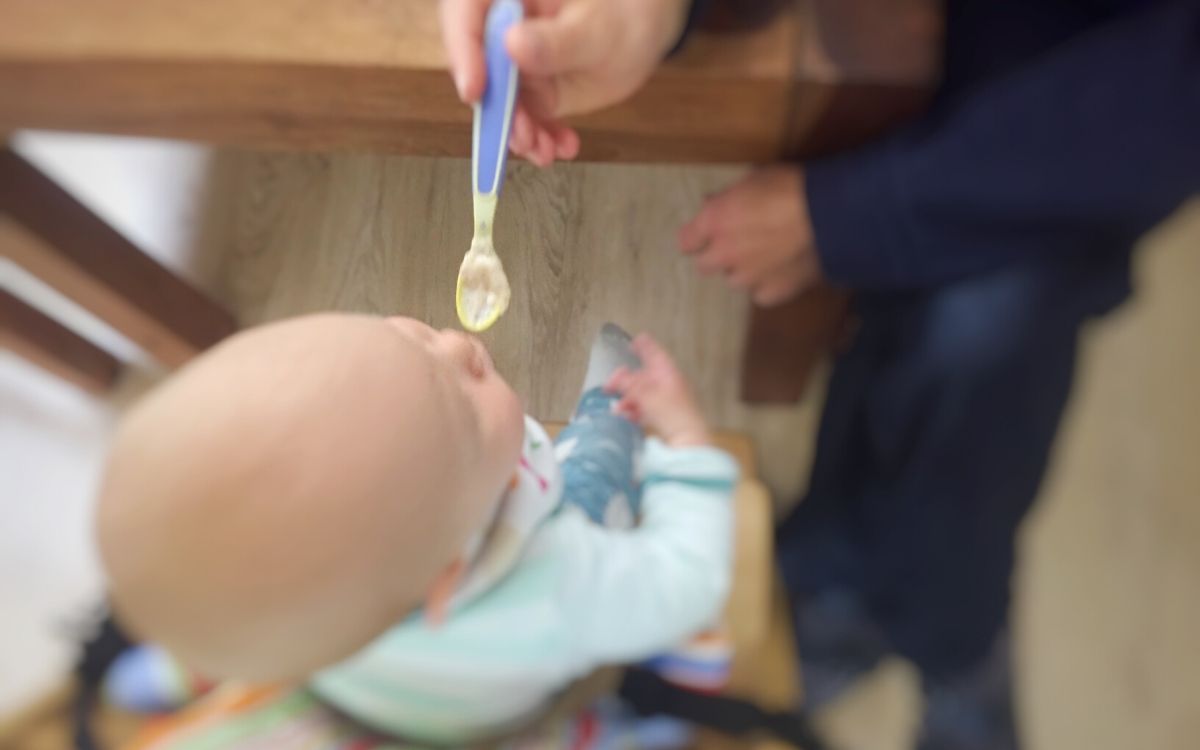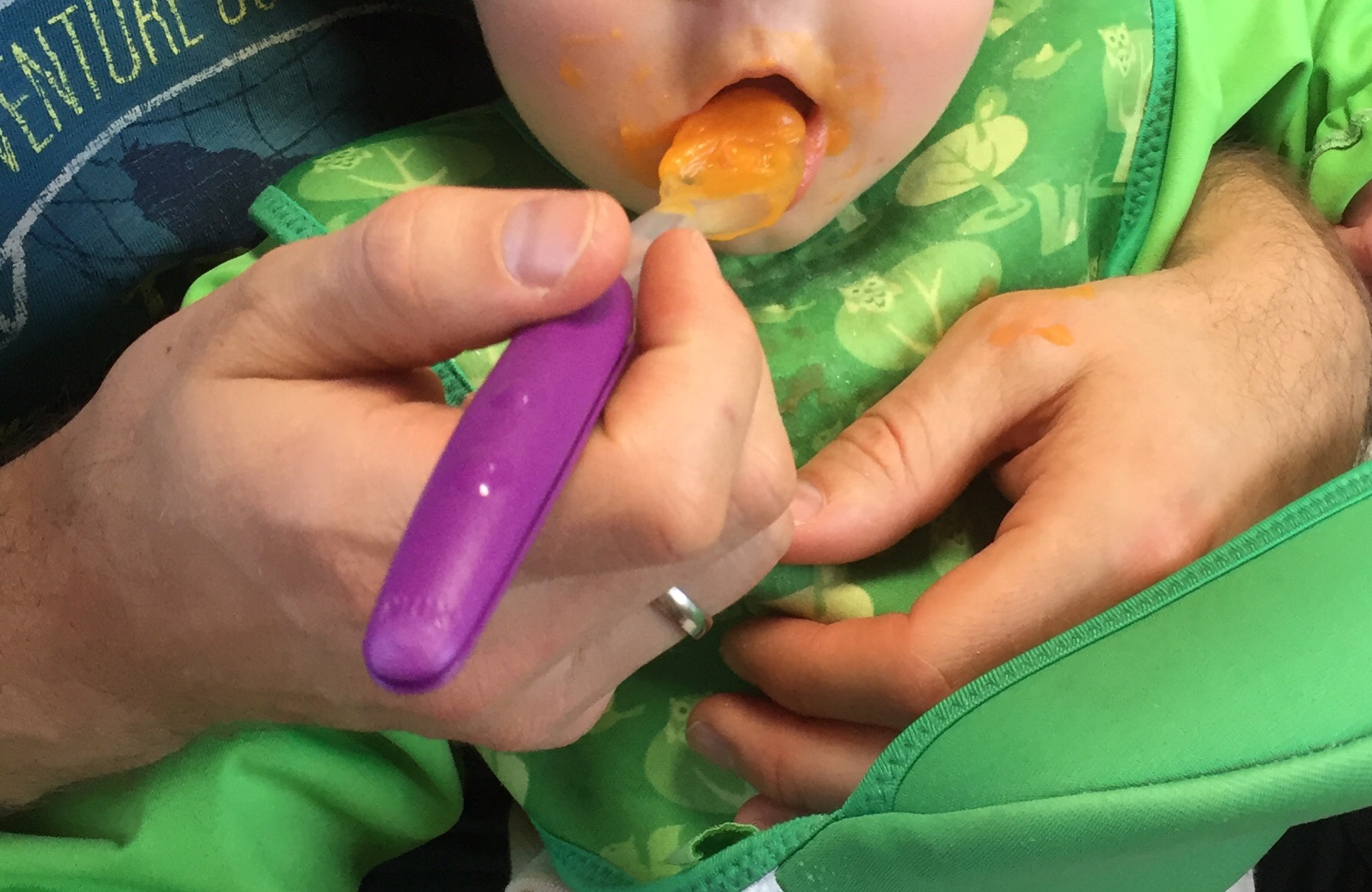Today I would like to talk about introducing solid food to your baby the German way and share our personal approach. I find it quite interesting that such an important step like changing from milk to solid food is still done very differently in various countries. Thanks to one of my readers (Hi Magge! :-)) I know that in the US you start with cereals mixed with formula or breastmilk before progressing to meat. And I have heard that in Asia rice plays an important role from the beginning. I thought I start with pointing out the official German recommendations for introducing solid food before I talk about how we did it. At the end of the article I have placed an overview and the recipes of the three purees I will introduce here as an pdf-file to download.
[Transparency: This post contains unpaid advertisement and affiliate links]
Introducing solid food to your baby the German way – official recommendations
When I started to do research about how to introduce solid food to my little one I turned to the website of Baden-Württemgberg and found this brochure: Von Anfang an mit Spaß dabei – Essen und Trinken im ersten Lebensjahr. It points out all the official recommendations that are based on scientific research. Unfortunately it is written only in German. So here comes an overview about the main facts when introducing solid food to your baby the German way in English:
- Don’t start with solid food before the 5th month as it might overwhelm your baby’s body.
- Don’t wait longer than the 7th month as breast milk or formula won’t supply enough iron and zinc in the second half of the first year anymore
- Trust your baby. It will show you when it is ready for solid food. Indicators are when it is interested in what’s on your plate, when it tries to grab your food and when it opens it’s mouth so that you can give him or her a spoonful. Your baby should be able to sit upright and turn it’s head away from the food before you start introducing solids.
- In Germany we start with a vegetable-potato-meat-puree. It is full of iron and zinc and thus provides exactly what your baby needs after the first 6 months. This puree is usually served as lunch.
- Vitamin C is important to help the body absorb the iron so it should be part of every lunch. You can for example mix 3-4 teaspoons of apple- or orange juice in the puree or offer your baby fruit puree for dessert.
- In order to help your baby to get used to solid food you should start with introducing just one sort of vegetable at a time and just offer a few spoons. Increase the amount from day to day and introduce other vegetables, then start mixing the vegetables with potatoes and add one tablespoon of oil. Use high quality and organic oil. Rapeseed oil is particularly good but linseed oil, sunflower seed oil or soy oil are also suitable.
- Replace the meat once or twice a week with fish. Salmon, cod and haddock are very healthy for your baby.
- If you are skeptical about introducing meat at such a young age vegetarian alternatives are 10 g millet or oat flakes. They are a good source of iron, too. Add 3-4 tablespoons of apple or orange juice or fruit puree as iron from plant sources is harder to absorb for the body and the vitamin C is very needed. Raising your baby vegan is not recommended.
- Between month 6 and 8 the second puree follows: The official German recommendations state that it is now time to introduce milk-grain-puree as dinner. This is the first time the baby gets introduced to whole milk. It is a good source of calcium, proteins and iodine however you can also use formula or breastmilk for this puree. Fruit is also part of this puree in order to help the body absorb the iron of the grains.
- The third puree is introduced between month 7 and 9 as afternoon-meal. The grain-fruit-puree is prepared without milk.
- Water is introduced with the third puree. 200 ml spread over the day is sufficient until the baby starts eating what you are eating, then the amount should be raised to 600 ml.
Introducing solid food to your baby the German way – recipes
Here come the official recipes for the three purees named above:
Vegetable-potato-meat-puree
100 g vegetables
50 g potatoes
30 g meat or fish
1 ts oil
3–4 tsp fruit puree or juice
Cut the vegetable, potatoes and meat/fish in small pieces and steam for 10-15 min. Add 1 tablespoon of oil and blend everything. Add water until the consistency is as your baby likes it. Add the fruit puree or juice into the puree or serve the puree as dessert.
Milk-grain-puree
200 ml whole milk (3,5 %–3,8 % fat)
20 g grain (flakes)
20 g fruit puree
Bring the milk to boil and add the grain. Let swell for 3-5 minutes on low heat. Let puree cool down a bit and then add the fruit puree.
Grain-fruit-puree
90 ml water
20 g grain
100 g fruit
1 ts oil
Bring water to boil and add the grain. Let swell for 2-3 minutes on low heat. Let cool down a bit and then add the fruit puree and oil.
Always check the temperature of the puree before you serve it to your baby!
Introducing solid food to your baby the German way – our approach
We started introducing solid food when our little one was 6 months old. She was interested in our food before, around month five, so we sometimes handed her steamed veggies from our plates to nibble on. For one month or so we introduced vegetable after vegetable and fed her the same veggie puree for 3-5 days before we introduced a new one. She loved fennel, parsnip, sweet potato, peas, regular potato, broccoli and avocado. Then we added potato and millet flakes and finally twice a week meat.
I wanted to prepare all her purees myself at the beginning in order to introduce her to the real tastes. I loved this blender from Philips Avent [affiliate link], it was so super easy to use and saved us much time and trouble. We bought it on our Elternzeit trip in Australia and it was a lifesaver in the camper van and also later at home.
I always used and still use millet flakes and not the normal grains. Just because it makes preparing the puree a bit easier. I use the organic flakes/Hirseflocken from Alnatura which can be purchased at dm for example.
When the little one was 7 months old we introduced the milk-grain-puree. I am a big fan of the products from Holle as they follow very high organic standards. Her favorite is Holle Babybrei Grieß (semolina) [affiliate link] but we also feed her Holle Babybrei Dinkel (spelt) [affiliate link] sometimes to mix it up a bit.
When she turned 8 months we started to introduce the grain-fruit-puree. However, she is not a big fan and didn’t eat much. So we prepare it with milk now as well. Babies under 1 year of age shouldn’t consume more than 200 ml of milk per day but as she is only eating 100 ml of her milk-grain-puree it isn’t a problem when we feed her 100 ml of the same puree again. And when she eats more we stretch it with water.
She is now nearly 10 months old and we have started feeding her chunkier pieces so that she can train her jaw muscles. We give her whole grain bread (finely grounded so that she can’t choke anything), penne, pieces of avocado, banana and very soft pear and sometimes Holle baby rusks [affiliate link] and lentil-rice-curls from dm babylove.
With the third puree we have also introduced water and tea. We started with this baby fennel tea from Alnatura [affiliate link] but she is also fine with plain water now. We use a learner cup like this one from Nuk [affiliate link].
By the way we use this oil from Holle [affiliate link] for the purees.
I still try to prepare most of her purees myself but sometimes there is just not enough time. For these occasions I have a selection of organic puree jars at home:
I also find it very helpful to have some organic meat jars at hand that I can simply mix into any vegetable puree.
Tipp from a local mom: If you want to serve your baby high quality organic vegetables or meat look for the Demeter sign. The Demeter certification shows that the farmers are following biodynamic standards which are higher than all other organic standards. Find out more on the Demeter website.
Please note that I am not saying we are doing it right! You do you and what is best for your baby 🙂
For more information about introducing solid food the German way you can check out this article on Gravidamiga that is co-written by a German midwife.
Download the overview
For your convenience I have put together the main aspects about introducing solid food to your baby the German way and the recipes for the three purees in an pdf-file that you can download here for free:
What do you think about the German way of introducing solid food to your baby? And what approach are you following?
Transparency:
This post contains non-paid advertisements as well as affiliate links to amazon.com. When you follow an affiliate link and buy something on amazon I get a little compensation while you don’t pay more. This is part of my income as blogger.


















Being the mom of a 10 months old baby in Stuttgart - Living in Stuttgart
• 4 years ago[…] purrees I make her as well as little samples of our food. If you are curious to find out more about the German way of introducing solid food to your baby check out this article that I have put together a few weeks […]